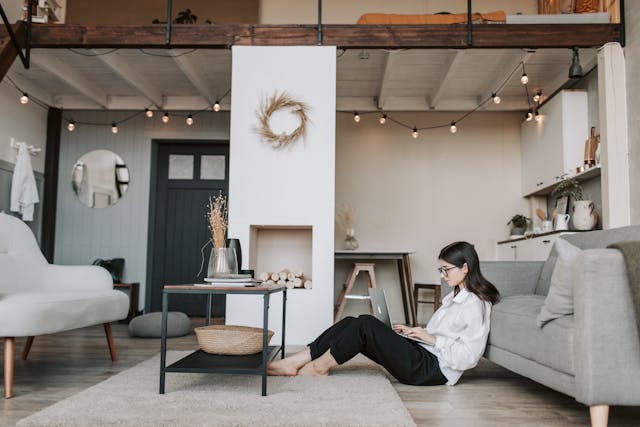A home should feel like a sanctuary that nurtures rest, warmth, and belonging. Creating consistent comfort is not about luxury but about balance, practicality, and emotional connection. Every household can achieve it through mindful choices that combine atmosphere, functionality, and personal expression.
Comfort doesn’t have a universal formula. It grows from how people live, what they value, and how their environment supports their daily lives. Whether it’s the right temperature, soft lighting, or a sense of calm organization, each detail contributes to the feel of the home.

Temperature Control and Air Quality
Few things influence comfort more than temperature. A home that maintains a steady, pleasant climate promotes relaxation and productivity throughout the day. Investing in expert AC repair and heating service in Dallas for reliable heating, ventilation, and air conditioning systems can help maintain that balance year-round. Good insulation prevents unwanted drafts and energy waste, keeping indoor air fresh and stable.
Air purifiers or plants can further improve air quality, reducing allergens and pollutants that often cause fatigue or irritation. Households that take time to fine-tune these environmental factors often experience better sleep, clearer minds, and a deeper sense of physical ease. Every breath should feel light and refreshing inside the home.
Lighting That Adapts to Every Mood
Lighting sets the tone for every corner of a home. Natural light boosts mood and energy, while soft artificial lighting brings calm during evenings. Using layered lighting, ambient, task, and accent, gives flexibility to match the moment.
Adjustable brightness and warmer tones create cozy settings that support rest or intimate gatherings. Dimmers or smart lighting systems help tailor illumination to suit activities, whether it’s reading, dining, or unwinding.
Many homeowners overlook the emotional impact of lighting, but it often defines how a space feels. A well-lit room balances clarity and calm, guiding energy and emotion throughout the day.
Thoughtful Furniture and Layout Choices
Comfort begins with how furniture supports daily living. Pieces that are functional, ergonomic, and proportionate to the space help prevent clutter and physical strain. Sofas, chairs, and mattresses should provide support without sacrificing softness.
Layout plays an equally crucial role. Arranging furniture to encourage natural movement and conversation makes rooms feel more open and inviting.
Multipurpose furniture, like ottomans with storage or extendable tables, adds adaptability for changing needs. Households that consider aesthetics and function create environments where relaxation comes naturally. Every seat, surface, and walkway should feel intentional and unobstructed, promoting a flow that invites ease.
Textures, Fabrics, and Personal Touches
The tactile experience of a home influences comfort as much as visual design. Soft blankets, plush rugs, and breathable fabrics invite touch and warmth. Mixing textures, linen, wood, wool, or metal, creates depth and sensory balance that makes spaces come alive.
Beyond physical comfort, personal items like photographs, artwork, or heirlooms provide emotional warmth. These touches remind residents of who they are and what they love. A balance between style and sentiment prevents a home from feeling impersonal or overly curated.
Organized and Clutter-Free Living Spaces
A comfortable home thrives on order. Clutter, even when subtle, can add tension and distraction. Establishing smart storage systems allows households to keep spaces open without sacrificing accessibility.
Decluttering contributes to mental clarity and emotional ease. Shelves, baskets, and modular cabinets help keep important items in reach while maintaining visual calm.
Regular upkeep, such as weekly tidying or seasonal sorting, reinforces a sense of control over the environment. When everything has a place, movement feels effortless, and focus improves. A clear space often mirrors a clear state of mind, which sustains comfort long-term.
Sensory Details and the Power of Ambiance
Comfort engages all the senses. Scents from candles, diffusers, or freshly brewed coffee can instantly shift mood and perception. Gentle background sounds, like soft music or the hum of nature outside, bring an extra layer of calm.
Even temperature contrast, such as a cool bedroom and warm bath, contributes to a harmonious rhythm in the home. Paying attention to sensory balance helps build emotional stability and relaxation.
Households that consider these subtleties often find joy in daily routines, transforming ordinary spaces into personal retreats. Every sense should find something soothing to hold onto within the home.

A consistently comfortable home grows from awareness and care. When temperature, light, texture, and organization align with personal needs, comfort becomes a living experience that renews itself daily.
By paying attention to physical and emotional cues, households can craft environments that restore, inspire, and welcome. A truly comfortable home is one where people can breathe deeply, move freely, and feel entirely themselves day after day.


